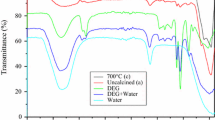Abstract
A study is made of how the granulometric composition and porosity of powders of solid solutions in the system Sn(IV)−Sb−O is affected by the conditions of precipitation of mixtures of tin hydroxide and antimony hydroxide and the heat-treatment temperature. Powders of tin and antimony hydroxides have a microporous structure and a high (≥200 m 2/g) specific surface. Heat treatment above 870 K forms Sn1−xSbxO2 solid solutions, this being accompanied by an increase in the size of the particles and transformation of the microporous structure to a mesoporous structure. An increase in the antimony content of the solid solutions helps form finer powders. A examination is made of the parameters of the pore structure of bulk specimens of semiconductor gas sensors obtained by heat-treating mixtures of powders of solid solutions and ultrafine clay.
Similar content being viewed by others
References
V. G. Grebenkina, Yu. P. Yusov, and V. N. Sorokin,Bulk Resistors [in Russian], Nauk. Dumka, Kiev (1976).
D. R. Pyke, R. Reid, and R. J. Tilley, “Structure of tin-antimony catalysts,”J. Chem. Soc. Faraday Trans. 1,76, 1174–1182 (1980).
D. E. Dyshel', L. E. Eremina, N. P. Maksimovich, and B. M. Rud', “Adsorption sensor for ethyl alcohol vapor based on powders of alloyed tin dioxide,”Poroshk. Metall., No. 3, 95–98 (1989).
L. M. Sharygin, V. F. Gonchar, and V. I. Byrybin, “Study of the thermal stability of hydrated tin dioxide obtained by the ash-gel method,”Izv. Akad. Nauk. SSSR. Neorg. Mater.,17, No. 10, 1804–1808 (1981).
M. V. Vlasova, D. E. Dyshel', and N. G. Kakazei, “Formation of disperse particles in the heat treatment of mixtures of hydroxides of tin and antimony,”Izv. Akad. Nauk SSSR. Neorg. Mater. 26, No. 7, 1486–1490 (1990).
D. E. Dyshel, “Properties of powders of the Sn(IV)−Sb−O system and the resistivity of resistive thick films based on them,”Izv. Akad. Nauk SSSR. Neorg. Mater. Nos. 3–4, 66–71 (1994).
D. E. Dyshel, “Effect of the composition of Sn x Sb1−x O2 solid solutions on the sensitivity of semiconductor gas sensors,”Izv. Akad. Nauk SSSR. Neorg. Mater. Nos. 5–6, 96–99 (1996).
P. A. Cox, R. G. Egdell, C. harding, et al., “Surface properties of antimony doped tin (IV) oxide: a study by electron spectroscopy,”Surf. Sci.,123, Nos. 2–3, 179–203 (1982).
D. A. Friedrichsberg,Course in Colloid Chemistry [Russian translation], Khimiya, Leningrad (1984).
H. Torvela and S. Leppavouri, “Microstructure and conductivity of short duration sintered tin oxide ceramics,”Int. J. High Technology Ceramics,3, No. 4, 309–319 (1987).
V. V. Skorokhod and S. M. Solonin,Physico-Metallurgical Principles of the Sintering of Powders [in Russian], Metallurgiya, Moscow (1984).
L. T. Grigoryan, Dzh. A. Gedakyan, and K. A. Kostanyan, “Activated sintering of tin dioxide,”Izv. Akad. Nauk SSSR. Neorg. Mater. 12, No. 2, 360–361 (1976).
L. I. Trusov, V. N. Lapovok, V. G. Gryaznov, et al., “Mass transport processes in ultradisperse media,” in:Properties and Use of Disperse Powders [in Russian], Nauk. Dumka, Kiev (1986), pp. 98–114.
L. M. Sharygin, “Formation of the pore structure of an absorbent during the during of the gel,”Zh. Fiz. Khim.,53, No. 3, 706–710 (1979).
K. Sing, “Use of physical adhesion to determine the surface area and size distribution of pores,” in:Methods of Studying Catalysts [Russian translation], Mir, Moscow (1983), pp. 20–38.
Additional information
Institute for Problems of Materials Science, Ukraine National Academy of Sciences, Kiev. Translated from Poroshkovaya Metallurgiya, Nos. 5–6(407), pp. 111–116, May–June, 1999.
Rights and permissions
About this article
Cite this article
Dyshel', D.E., Lobunets, T.F. Effect of heat treatment on the dispersity of Sn(IV)—Sb—O powders and the porosity of thick-film gas sensors based on them. Powder Metall Met Ceram 38, 309–313 (1999). https://doi.org/10.1007/BF02675782
Received:
Issue Date:
DOI: https://doi.org/10.1007/BF02675782




